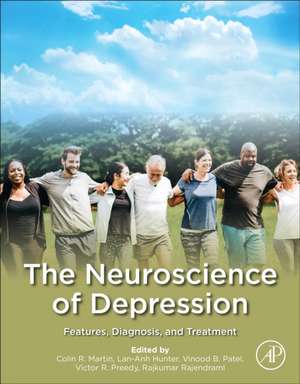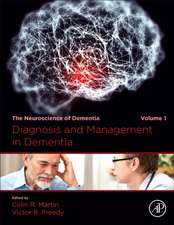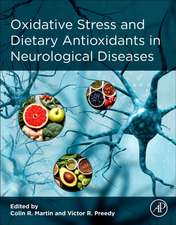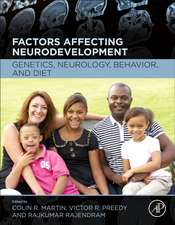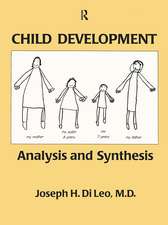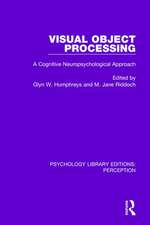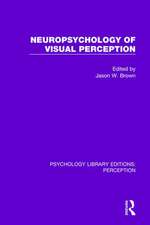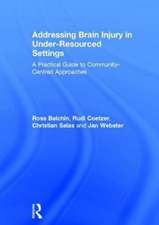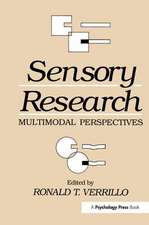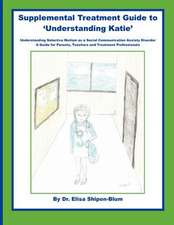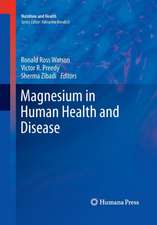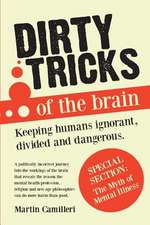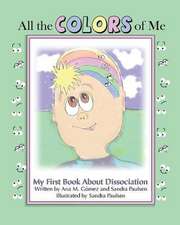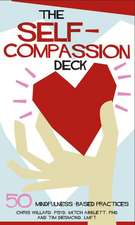The Neuroscience of Depression: Features, Diagnosis, and Treatment
Editat de Colin R Martin, Lan-Anh Hunter, Vinood B. Patel, Victor R. Preedy, Rajkumar Rajendramen Limba Engleză Paperback – 30 iun 2021
- Covers a pharmacological and behavioral treatment options
- Features sections on diagnosis and biomarkers of depression
- Discusses depression in children, teens and adults
- Contains information on comorbidity of physical and mental conditions
- Includes more than 250 illustrations and tables
Preț: 693.29 lei
Preț vechi: 892.15 lei
-22% Nou
Puncte Express: 1040
Preț estimativ în valută:
132.68€ • 144.07$ • 111.45£
132.68€ • 144.07$ • 111.45£
Carte disponibilă
Livrare economică 25 martie-08 aprilie
Preluare comenzi: 021 569.72.76
Specificații
ISBN-13: 9780128179338
ISBN-10: 0128179333
Pagini: 592
Ilustrații: Approx. 250 illustrations (250 in full color)
Dimensiuni: 216 x 276 x 31 mm
Greutate: 1.68 kg
Editura: ELSEVIER SCIENCE
ISBN-10: 0128179333
Pagini: 592
Ilustrații: Approx. 250 illustrations (250 in full color)
Dimensiuni: 216 x 276 x 31 mm
Greutate: 1.68 kg
Editura: ELSEVIER SCIENCE
Cuprins
I. Depression: Introductory Chapters
1. Clinical staging in depression
2. Neurodevelopmental theory of depression
3. Depression after pregnancy
4. Modeling maternal depression during pregnancy: Rodent models of Major Depressive Disorder with Peripartum Onset
5. Depression in mothers and mental health in children: Impact, risk factors and interventions
6. Depression in college students
7. Depression in disasters and traumatic events
8. Depression and associated Alzheimer s disease
9. Comorbidities of depression and Parkinson's disease
10. Understanding the relationship between depression and alcohol among students
11. Depression in obesity
12. Depression and heart rate variability
13. Neuroinflammation and depression
14. Interlinking antidepressants and the immune system
II. Biomarkers and Diagnosis
15. Assessment scoring tools of depression
16. The Beck Depression Inventory: Uses and applications
17. The Hamilton Depression Rating scale: Uses and applications
18. The Patient Health Questionnaire (PHQ)
19. Screening for Antenatal Depression (AND) using self-report questionnaires: Conceptual issues and measurement limitations
20. Edinburgh Postnatal Depression Scale: Description and applicationsJacqueline
21. The Death Depression Scale: Description and applications
22. Depression Anxiety Stress Scales: Features and Applications
23. Arabic version of the two-question Quick Inventory of Depression: Description and applications (QID-2-Ar)
24. Depressive Symptoms and Biomarkers of Cardiovascular Disease
25. Thioredoxin as an antioxidant protein as a marker in depression
26. Methods of neuroimaging in depression: Applications to resting-state functional connectivity
27. Neural markers of depression in MRI
III. Pharmacological Treatments for Depression
28. Angiotensin receptor 1 blockade as an antidepression strategy
29. Cannabinoid CB1 receptors and antidepressant effects
30. Agomelatine: profiles and applications to depression
31. Bumetanide and use in depressive states
32. Linking citalopram, serotonin reuptake inhibitors and depressed pregnant women
33. Citalopram and usage in sleep-deprivation-induced depression
34. Monoaminergic System and Antidepressants
35. Duloxetine usage in depression
36. Escitalopram and blonanserin as antidepressant agents linking in neurotrophic mechanisms
37. Ketamine and the role of (2R,6R)-Hydroxynorketamine in depression
38. Linking 5-Hydroxytryptamine, antidepressant actions of (R)-Ketamine and social stress model
39. Mirtazapine: Multi-target strategies for treating substance use disorder and depression
IV. Counselling, Psychotherapy and Behavioural Treatments for Depression
40. Mindfulness-based cognitive therapy and depression
41. Online (web based) programs for depression
42. Clay art therapy on emotion regulation: Research, theoretical underpinnings, and treatment mechanisms
43. Solution-focused counselling: and use in postpartum depression
44. Transcranial direct current stimulation (tDCS) combined with cognitive emotional training (CET) as a novel treatment for depression
V. Other Aspects of Treatment: Specific Groups, Monitoring and Novel Regimens
45. Putative effects of cannabidiol in depression and synaptic plasticity
46. Tanscutaneous vagus nerve stimulation in depression
47. Exercise for depression as a primary and comorbid with obesity disorder: A narrative
48. Acupressure and depression: a scientific narrative
49. Potential beneficial effects of Bifidobacterium breve A1 on cognitive impairment and psychiatric disorders
50. Coenzyme Q and use in depression
51. Gene expression in Major Depressive Disorder: peripheral and brain based studies
52. Electroconvulsive therapy for depression: effectiveness, cognitive side-effects and mechanisms of action
53. Depression and offspring DNA methylation
54. Other Aspects of Treatment: Specific Groups, Monitoring and Novel Regimens: Treating depression with Theta burst stimulation (TBS)
1. Clinical staging in depression
2. Neurodevelopmental theory of depression
3. Depression after pregnancy
4. Modeling maternal depression during pregnancy: Rodent models of Major Depressive Disorder with Peripartum Onset
5. Depression in mothers and mental health in children: Impact, risk factors and interventions
6. Depression in college students
7. Depression in disasters and traumatic events
8. Depression and associated Alzheimer s disease
9. Comorbidities of depression and Parkinson's disease
10. Understanding the relationship between depression and alcohol among students
11. Depression in obesity
12. Depression and heart rate variability
13. Neuroinflammation and depression
14. Interlinking antidepressants and the immune system
II. Biomarkers and Diagnosis
15. Assessment scoring tools of depression
16. The Beck Depression Inventory: Uses and applications
17. The Hamilton Depression Rating scale: Uses and applications
18. The Patient Health Questionnaire (PHQ)
19. Screening for Antenatal Depression (AND) using self-report questionnaires: Conceptual issues and measurement limitations
20. Edinburgh Postnatal Depression Scale: Description and applicationsJacqueline
21. The Death Depression Scale: Description and applications
22. Depression Anxiety Stress Scales: Features and Applications
23. Arabic version of the two-question Quick Inventory of Depression: Description and applications (QID-2-Ar)
24. Depressive Symptoms and Biomarkers of Cardiovascular Disease
25. Thioredoxin as an antioxidant protein as a marker in depression
26. Methods of neuroimaging in depression: Applications to resting-state functional connectivity
27. Neural markers of depression in MRI
III. Pharmacological Treatments for Depression
28. Angiotensin receptor 1 blockade as an antidepression strategy
29. Cannabinoid CB1 receptors and antidepressant effects
30. Agomelatine: profiles and applications to depression
31. Bumetanide and use in depressive states
32. Linking citalopram, serotonin reuptake inhibitors and depressed pregnant women
33. Citalopram and usage in sleep-deprivation-induced depression
34. Monoaminergic System and Antidepressants
35. Duloxetine usage in depression
36. Escitalopram and blonanserin as antidepressant agents linking in neurotrophic mechanisms
37. Ketamine and the role of (2R,6R)-Hydroxynorketamine in depression
38. Linking 5-Hydroxytryptamine, antidepressant actions of (R)-Ketamine and social stress model
39. Mirtazapine: Multi-target strategies for treating substance use disorder and depression
IV. Counselling, Psychotherapy and Behavioural Treatments for Depression
40. Mindfulness-based cognitive therapy and depression
41. Online (web based) programs for depression
42. Clay art therapy on emotion regulation: Research, theoretical underpinnings, and treatment mechanisms
43. Solution-focused counselling: and use in postpartum depression
44. Transcranial direct current stimulation (tDCS) combined with cognitive emotional training (CET) as a novel treatment for depression
V. Other Aspects of Treatment: Specific Groups, Monitoring and Novel Regimens
45. Putative effects of cannabidiol in depression and synaptic plasticity
46. Tanscutaneous vagus nerve stimulation in depression
47. Exercise for depression as a primary and comorbid with obesity disorder: A narrative
48. Acupressure and depression: a scientific narrative
49. Potential beneficial effects of Bifidobacterium breve A1 on cognitive impairment and psychiatric disorders
50. Coenzyme Q and use in depression
51. Gene expression in Major Depressive Disorder: peripheral and brain based studies
52. Electroconvulsive therapy for depression: effectiveness, cognitive side-effects and mechanisms of action
53. Depression and offspring DNA methylation
54. Other Aspects of Treatment: Specific Groups, Monitoring and Novel Regimens: Treating depression with Theta burst stimulation (TBS)
